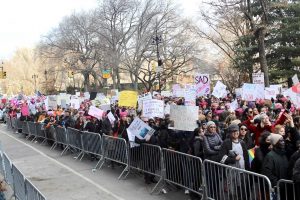by Erin Cabrey

The Women’s March in New York City last year, which occurred the day after President Donald Trump’s inauguration, was full of anger, frustration and rebellion in addition to immense hopefulness as an unprecedented number of people took to the streets to evoke change. The march was based in the fear of the promises Trump had built his campaign on, as well as what the President would do with his four years in office, with accusations of racism, sexism and homophobia looming over the administration. This year’s Women’s March was flooded with New Yorkers equipped with a year of knowledge, though many most likely wished they could turn back the clock. After 12 months of hateful tweets, travel bans and porn star scandals (to name only a few), marchers were ready to take to the streets once again to protest for a better America, though they didn’t always know exactly how to do that best.
This year’s NYC Women’s March, though slightly less attended than last year’s, was not any less exuberant. Marchers across races, genders and ages broke out their pink pussy hats and raised high their powerful and often clever signs. They came prepared, as they did last year, with something to say.
Marchers felt just slightly more hopeful than last year, perhaps because time had softened the blow of a Trump presidency or because the organization, Time’s Up, provided a much-needed blow to the patriarchy. The mood was both angry and hopeful as the crowd still voiced their frustrations, in ways that often felt to me to be destructive to the overall movement. Chants repeated through the crowd echoed malice toward Trump and made fun of his “tiny hands” and his Tweets. One sign at the end of the march even illustrated Trump as the poop emoji. Marchers booed Trump Tower when they passed and yelled “Shame!” when Fox News came into sight. Americans have a long list of incredibly valid reasons why they should be furious at the Trump administration, of course, but such negativity will not solve anything, and as I marched I felt uncomfortable with these sentiments and was ultimately reluctant to take part. My heart filled with admiration for the people around me when the crowd yelled “Say it loud, say it clear, immigrants are welcome here,” and held signs that said “Time’s Up” or “Black Lives Matter,” but I felt tinges of embarrassment when people used their platform to simply mock Trump.
Those who instead chanted “This is what democracy looks like” made a much larger statement in my eyes. Without sounding too naive or sentimental, these are the moments during the march that touched my heart. At one point as the march reached Midtown, a group of young girls cheered on those that passed them by and held up “girl power” signs while chanting the same slogan. At this moment I felt a strong sense of responsibility for myself and my fellow marchers to set an example for the these girls by promoting messages that are empowering and meaningful. Instead of stooping to Trump’s level, it is much more impactful to promote the messages of the people and movements that do matter and chose not to participate in chants of anger but scream “Girl Power” as loud as we can.
The majority of the crowd and the march, overall, made me feel hopeful for the future, and I do believe that, though there are still several kinks to be worked out, the Women’s March is incredibly crucial in mobilizing Americans to stand up against bigotry and hatred and use their voices to promote love and change. Though that sounds like a romantic notion, it is true that within that crowd of such a variance in demographics I could feel a true sense of hope that we as a nation can move toward a better future for our country.
After I returned home from the march, I saw an Instagram post of a little girl at the march with a sign around her neck that read “I marched before I walked,” and all I could think about was how that young girl most likely did not know a world where women did not take to the streets and raise their voices for all to hear. It is our responsibility to demonstrate to the younger generations who have known no one but Trump as their president how to effectively use their voices, even if we all are still learning how to do this too.
Ultimately, my one wish for the next Women’s March is that the movement can keep moving forward with the messages of intersectionality, inclusion and resistance of injustice, as well as create a more cohesive understanding of the best way to pursue change in this tumultuous administration. It may seem hard, and I truly don’t know the perfect way to do this, but I think if we abide by the guiding words of Michelle Obama, “When they go low, we go high,” we might all have a fighting chance.
Erin Cabrey, FCRH ’18, is an journalism major from Greenland, New Hampshire.


































































































































































































